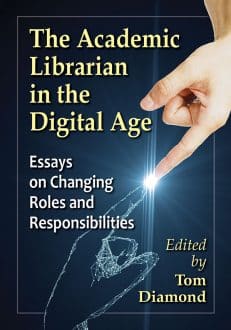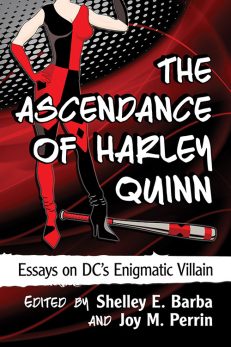The Ascendance of Harley Quinn
Essays on DC’s Enigmatic Villain
$19.99
In stock
About the Book
Since her first appearance in 1992, Harley Quinn—eccentric sidekick to the Joker—has captured the attention of readers like few new characters have in eight decades of Batman comics. Her bubbly yet malicious persona has earned her a loyal and growing fan base as she has crossed over into television, theater, video games, and film. In this collection of new essays, contributors explore her various iterations, focusing on her origin and contexts, the implications of her abusive relationship with the Joker, her relationships with other characters, her representations across media, and the philosophic basis of her character.
Instructors considering this book for use in a course may request an examination copy here.
About the Author(s)
Bibliographic Details
Edited by Shelley E. Barba and Joy M. Perrin
Format: softcover (6 x 9)
Pages: 239
Bibliographic Info: appendix, notes, bibliography, index
Copyright Date: 2017
pISBN: 978-1-4766-6523-8
eISBN: 978-1-4766-2999-5
Imprint: McFarland
Table of Contents
Acknowledgments vi
Introduction 1
Part 1. The Setup
“It is to laugh”: The History of Harley Quinn (Emilee Owens) 3
Harlequin Romance: The Power of Parody and Subversion (Cia Jackson) 16
She Laughs by Night: Mad Love, the New 52 and Noir (Gregory Bray) 30
The Clock Is Ticking (Brandon Benge) 43
Part 2. Relationship with the Joker
“That just proves he wants me back”: Pure Victimhood, Agency and Intimate Partner Violence in Comic Book Narratives (K. Scarlett Harrington and Jennifer A. Guthrie) 55
Bride of the Monster: Harley Quinn as a Case of Hybristophilia (Michał Siromski) 70
A New Kind of Leading Lady: The Complexity of Surviving Abuse and Becoming a Hero (Willmaria C. Miranda) 84
Part 3. Relationships with Others
Duality and Double Entendres: Bi-Coding the Queen Clown of Crime from Subtext to Canon (Alex Liddell) 93
Victim, Villain or Antihero: Relationships and Personal Identity (Amanda Hoyer) 107
“Stronger than their madhouse walls”: Disrupting Gotham’s Freak Discourse in “Mad Love” and “Harley Quinn” (Aidan Diamond) 120
Part 4. Representations
Arkham Origins: Looking at Grown-Up Themes Through the Lens of a Kid’s TV Show (Derek Moreland) 133
Harlequin, Nurse, Street Tough: From Non-Traditional Harlequin to Sexualized Villain to Subversive Antihero (Justin Wigard) 146
Problematic Fave: Gendered Stereotypes in the Arkham Video Game Series (Ian Barba) 157
The Motley Queen: A “Spicy Package” of Misrule (Erica McCrystal) 168
Part 5. Philosophy
There Shall Be Order from Chaos: Hope and Agency Through the Harlequine’s Subalternity (Michelle Vyoleta Romero Gallardo and Nelson Arteaga Botello) 177
The “Mistress of Mayhem” as a Proxy for the Reader: A Metafictional Link Between Fiction and Reality (Megan Sinclair) 190
Super-Villain or Sociopath: Evilness at the Turn of the Century (Fernando Gabriel Pagnoni Berns and Leonardo Acosta Lando) 203
Appendix: A Mediography of Harley Quinn (Joy M. Perrin) 215
About the Contributors 223
Index 227
Book Reviews & Awards
- “Essays offer plenty of food for thought and leave you trying to decide which side you fall on; is she a victim or villain?”–Artistic Bent
- “Has gained a large fanbase and quickly became one of DCs most popular female characters”–Sequart Organization
- “One of the most popular villains of the DC Comics universe…unique…fills the gaps”–Focus
- “One of the most popular characters in the DC comicsverse, Harley Quinn is adored by many despite her status as an antihero. This collection of essays is a welcome addition to the scholarship about female characters that are often overlooked in study of genre fiction.”—Sherry Ginn, Marvel’s Black Widow from Spy to Superhero






